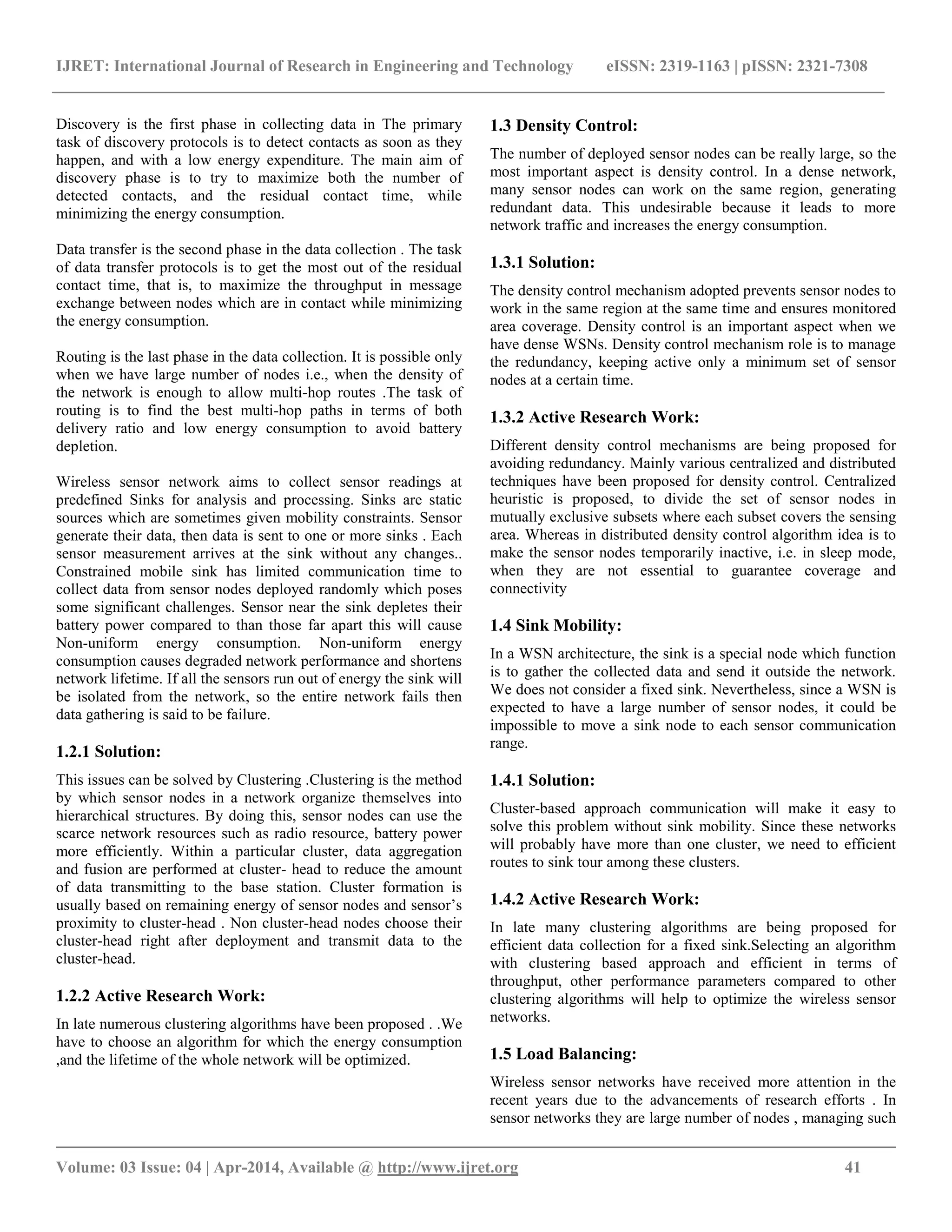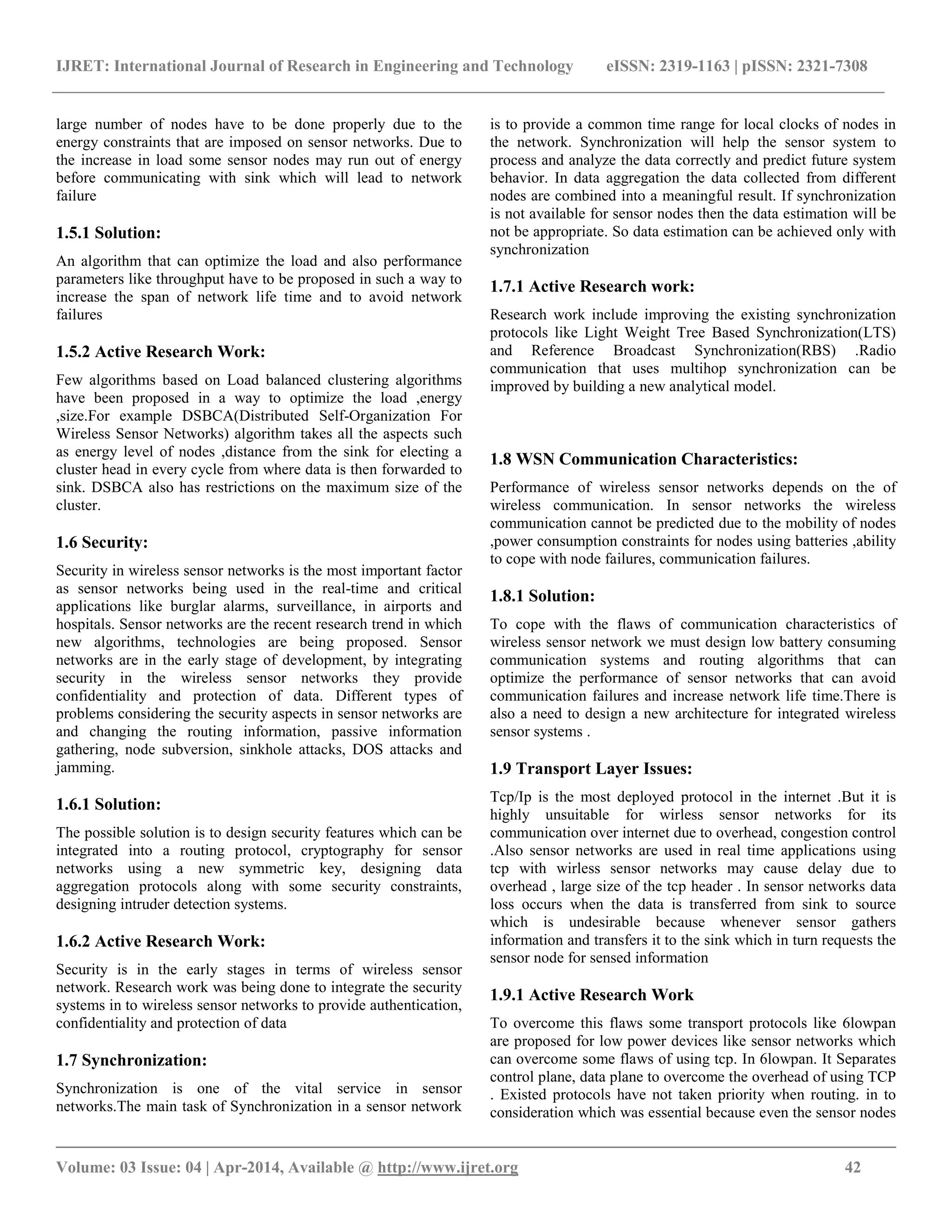This document discusses the optimization issues in wireless sensor networks (WSNs), focusing on challenges such as energy constraints, data collection, load balancing, and security. It outlines various strategies and ongoing research initiatives aimed at addressing these issues, including clustering algorithms, density control mechanisms, and enhancements to communication protocols. The paper emphasizes the importance of effective management and optimization techniques to ensure the longevity and performance of WSNs.
![IJRET: International Journal of Research in Engineering and Technology eISSN: 2319-1163 | pISSN: 2321-7308 __________________________________________________________________________________________ Volume: 03 Issue: 04 | Apr-2014, Available @ http://www.ijret.org 40 ISSUES IN OPTIMIZING THE PERFORMANCE OF WIRELESS SENSOR NETWORKS Rakesh.N1 , Kayalvizhi Jayavel2 1 Department of Information Technology, SRM University, Chennai-603203 2 Department of Information Technology, SRM University, Chennai-603203 Abstract Wireless sensor networks have attracted most of the research efforts due to the latest advancements in the field of sensing, computing and communication. Wireless sensor networks provide endless opportunities as well they pose formidable challenges primarily pertaining to energy constraints to which sensor nodes are particularly subjected .Issues like data collection, load balancing ,battery depletion have to be addressed at the cost of optimization of wireless sensor networks. This paper provides the ongoing research activities and possible solutions to the problems ------------------------------------------------------------------------***--------------------------------------------------------------------- 1. INTRODUCTION Wireless sensor networks are a large number of small sensing battery powered nodes which gather information and communicate in a wireless fashion to the base station. The WSN contains nodes which can vary from a few to several thousand depending on the type of the application being deployed ,where each node acts as a sensor. The topology of the WSNs can vary from a simple star network to an advanced multi-hop wireless mesh network. Propagation of data between the hops of the sensor network can be done either by routing or flooding. The fundamental task for wireless sensor network is data gathering which has became challenging factor due to the battery depletion, large number of nodes and certain other factors like hardware, operating system is responsible for it .Optimization of wireless sensor networks is possible only if we consider all the characteristics of Wireless sensor networks for resolving the issues which optimize the performance of the wireless sensor networks on the whole. 1.1 Characteristics of a Wireless Sensor Network The fundamental characteristics of a Wireless sensor network include: Energy consumption constraints for nodes using batteries: The nodes of wireless sensor networks are battery powered and in many cases no replacement of batteries can be done once deployed to the user .So, energy consumption has to be efficiently managed to increase the life time of the sensor networks [8]. Mobility of nodes: In Wireless sensor networks nodes can change their location with time. Mobility of nodes help us from the problems regarding the constraints of network connectivity. Communication failures: Communication is done by either flooding or routing. Communication devices mainly used in wireless sensor networks are the radio transceivers. Radio transceivers are the devices comprising of both transmitter and receiver to work within the radio frequency range . Communication failures occur due to battery depletion. Heterogeneity of nodes: Wireless sensor networks are provided with heterogeneity of nodes .For example three primary types of hardware heterogeneities are Computational heterogeneity in which some nodes are provided with extra computational abilities. Link heterogeneity, where some nodes are provided with long-distance highly reliable communication links . Energy heterogeneity where nodes have unlimited energy resources. Scalability to large scale of deployment Wireless sensor networks are scalable on a large scale. If sensor nodes are being deployed then battery cannot be changed and even providing maintenance cannot be possible. Issues that avoid the optimization of a wireless sensor network are 1.2 Data Collection The primary task of sensor nodes is systematic collection of data and transmit the gathered data in a wireless fashion to the base station i.e., Data collection. In wireless sensor networks nodes can communicate if and only if they are in common communication range. The time for which the nodes are in contact is defined as the contact time. The contact area is defined as the region where that node can possibly be in contact with other nodes. They are mainly three phases in data collection they are discovery, data transfer and routing.](https://image.slidesharecdn.com/issuesinoptimizingtheperformanceofwirelesssensornetworks-140812055913-phpapp01/75/Issues-in-optimizing-the-performance-of-wireless-sensor-networks-1-2048.jpg)


![IJRET: International Journal of Research in Engineering and Technology eISSN: 2319-1163 | pISSN: 2321-7308 __________________________________________________________________________________________ Volume: 03 Issue: 04 | Apr-2014, Available @ http://www.ijret.org 43 at different locations may have different priorities.Routing through multiple paths is under research. 1.10 Network Layer Issues: Routing is the most important service in wireless sensor communication. Battery depletion indirectly affects the routing as it leads to network failure .If the number of nodes are more in wirless communication it would be impossible for the sink to communicate to every node in single hop. 1.10.1 Solution: Several routing Protocols are being proposed for wireless sensor networks like LEACH(Low Energy Adaptive Cluster Hierarchy), TEEN(Threshold sensitive Energy Efficient sensor Network protocol), GEAR (Geographic and Energy Aware Routing), SAR (Sequential Assignment Routing),DSBCA (Distributed Self-Organization For Wireless Sensor Networks), SPIN(Sensor Protocols for Information negotiation)and others .Selecting the best routing protocol suitable to the requirements. 1.11 Deployment: Sensor nodes are deployed in a large scale over a particular region or a sensor field in a real-time environment. sensor nodes being deployed in real-time environment will provide wrong readings due to the battery depletion as no battery replacement is possible after deployment in wirless sensor networks .So issues affecting sensor nodes must be detected for avoiding the data loss. Also , concurrent transmission attempts done due to the deployment of sensor nodes will lead to congestion. 1.11.1 Active Research Work: Research work includes improving the range of the radio when deployed in various real time environment. Wrong sensor readings have to be detected as soon as possible to decrease latency and congestion. 2. CONCLUSIONS Wireless Sensor Networks created a wide range of oppurtunities as well as challenges that have to be addressed at the cost of optimization. In this paper we have identified a list of issues associated with Wireless Sensor Networks. We have discussed some solutions and active research work pertaining to these issues REFERENCES [1]. “A Review of Current Routing Protocols for Adhoc Wireless Mobile Networks”, IEEE Personal Communications, April 1999, pp 46-55. [2]. I. Akylidiz, W. Su, Sankarasubramaniam, and E.Cayrici, “A survey on sensor networks”, IEEE Communications Magazine, Volume: 40 Issue: 8, August 2002, pp.102-114. [3]. Q. Jiang and D.Manivannan, “Routing Protocols for Sensor Networks”, In proceedings of Consumer Communications and Networking Conference, 5-8 January, pp 93-98. [4]. Ning Xu, “A survey of Sensor Network and its Applications”,http://enl.usc.edu/~ningxu/papersurvey.pdf. [5]. K. Akkaya and M. Younis, “A survey of Routing Protocols in Wireless Sensor Networks”, Elsevier Ad Hoc Network Journal, 2005, pp 325-349. [6]. D.Culler, D.Estrin and M.Srivastava, “Overview of Sensor Networks”, IEEE Computer Society, August 2004 [7]. Ying Liao, Huan Qi, and Weiqun Li, “Load-Balanced Clustering Algorithm With Distributed Self-Organization for Wireless Sensor Networks” IEEE SENSORS JOURNAL, VOL. 13, NO. 5, MAY 2013. [8]. Daniele Puccinelli and Martin Haenggi “Wireless Sensor Networks:Applications and Challenges of Ubiquitous Sensing” IEEE CIRCUITS AND SYSTEMS 2005. [9]. “Data Collection in Wireless Sensor Networks with Mobile Elements: A Survey” Mario Di Francesco and Sajal K. DasCrewman, The University Of Texas At Arlington And GIUSEPPE ANASTASI, University of Pisa. [10]. “Issues in Wireless Sensor Networks”Gowrishankar.S , T.G.Basavaraju, Manjaiah D.H , Subir Kumar Sarkar Proceedings of the World Congress on Engineering 2008 Vol IWCE 2008, July 2 - 4, 2008, London, U.K.](https://image.slidesharecdn.com/issuesinoptimizingtheperformanceofwirelesssensornetworks-140812055913-phpapp01/75/Issues-in-optimizing-the-performance-of-wireless-sensor-networks-4-2048.jpg)